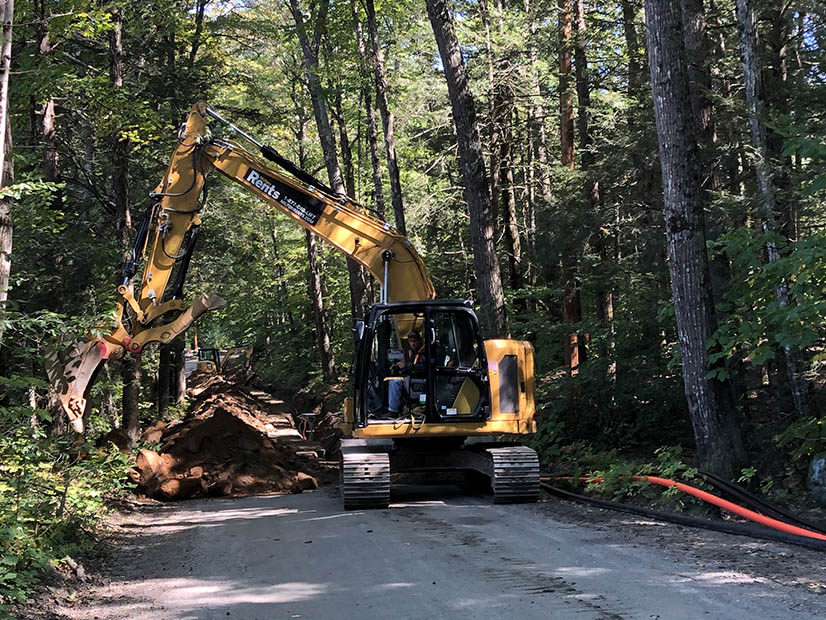
Hit by one storm after another, Vermont’s largest electric utility is proposing to install battery systems in certain customers’ homes as a resilience measure.
The plan is one piece of Green Mountain Power’s 2030 Zero Outages Initiative, which it calls a first-in-the-nation combination of hardening power lines, creating community microgrids and placing distributed storage assets strategically across its service area — then crunching external data to find the best strategy against power outages on each of 300 circuits.
GMP has been promoting in-home storage units for eight years, and its residential customers now have 5,000 battery units in their homes. The customer waitlist stood at 1,200 when the Vermont Public Utility Commission in August lifted the enrollment cap on two GMP programs to promote in-home storage.
Under one program, GMP leases Tesla Powerwall batteries to customers for 10 years at a discount; under the other, GMP provides an up to $10,500 incentive to ratepayers who buy a system on their own.
In a petition to the PUC Monday, GMP proposes to spend $280 million to increase storm resilience (Case No. 23-3501-PET). Some $250 million would be used to harden 8 to 10% of GMP’s 10,000 miles of overhead lines — either by moving them underground or by protecting them with spacer cables or other devices.
The other $30 million would place battery units in some homes in what GMP calls Zone 4 — areas served by single-phase “last-mile” power lines in rural areas. Some parts of the mountainous state have sufficiently few customers per mile that moving power lines underground or even just hardening them would be less economical than installing batteries.
The utility would cover the cost of the batteries so individual homeowners who couldn’t afford the upfront cost of a battery wouldn’t be left behind.
Ratepayers would pick up the tab, although GMP plans to pursue federal funding.
Other pieces of the puzzle include trailer-mounted energy storage, demand-response-enabled EV chargers and electric school buses with V2G capability.
GMP said the unique aspect of the 2030 Zero Outages Initiative is that it takes all these pieces and overlays them with federal community vulnerability data, topography and other metrics to calculate the best resiliency strategy for each circuit.
Utilities and grid operators nationwide are wrestling with the long-term implications of the clean energy transition and the immediate impact of extreme weather blamed on climate change.
In Vermont, the storms have been coming fast and furious. GMP has spent $115 million on repairs from major storms in the past decade, $45 million of it in just the past year. The three storms with the highest number of outages in GMP history have all hit in the past 12 months.
That is unsustainable, GMP said. It needs to accelerate resiliency efforts so future storms cause less damage and fewer outages.
GMP President Mari McClure said in a news release Tuesday: “We all see the severe impacts from storms, we know the impact outages have on your lives, and the status quo is no longer enough. We are motivated to do all we can to combat climate change and create a Vermont that is sustainable and affordable, but we must move faster. Together with our customers, regulators, our communities and that Vermont spirit that manages to innovate despite all odds, we have all we need to revolutionize the energy system and ensure a stronger, more affordable Vermont.”
If the PUC approves, the $280 million would be spent over the next two years. GMP said it expects the improvements to start yielding savings on storm recovery costs by 2026 and will submit a request for an expanded second phase of improvements to be made through 2030.
In a promising sign, the first 50 miles of power lines relocated underground came through the recent series of major storms undamaged and trees that fell on new spacer cables caused no outages.
GMP serves more than 270,000 homes and businesses in Vermont. It is by far the largest electric utility in the state, and the only one owned by investors.
A spokesperson told NetZero Insider Tuesday that GMP is confident it can secure enough storage units, even amid surging demand for batteries. It already has been working with suppliers.


